Hunting black bears, after you have spent some time hunting foxes and coyotes, is not a question of skill. You already have all the skills you need to call a bear, even to get a bear within archery range.
Instead, what will determine your success as a bear hunter is some basic knowledge, a bit of scouting, and some luck. And if luck smiles upon you, the bear doesn’t stand a chance.
Hunting black bears after you have predator hunted.
A bear’s number one defense mechanism against humans is its sense of smell. A bear sense of smell is seven times better than a bloodhound’s and 2,100 times better than yours.
As a predator hunter, you already have an answer to that problem: Playing the wind. The same tricks you used hunting eastern coyotes will serve you well here.
Related: What does black bear poop look like?
This video is from Kevin Rought of Michigan. Later in the article, we’ll see the eventual outcome of this hunt.
The bear’s second defensive tool the bear has is its vision. Don’t be fooled; black bears can see just as well as you can.
Avoid creating silhouettes and unnecessary movements. As for whether or not bears can see colors?
“After learning to associate food with color, bears were tested using identical containers in different shades. The “blue-trained” bear could correctly discern between blue and blue-gray, blue-green, blue-red and blue-yellow; the “green” bear could discriminate between green and similar shades.”
Again, a predator hunter with even a base level of experience can blend into his surroundings, break up his human silhouette, and become invisible to a bear
Lastly, a bear hearing is twice as good as yours, with the added ability to rotate each ear independently and listen to and analyze two different sounds simultaneously. https://www.wildrevelation.com/how-well-can-bears-hear/
Here, again, a predator hunter already routinely uses complete silence as a tool to success.
With all you predator skills already in your possession, what remains to ensure your success during bear hunting?
Scout before you start hunting black bears.
Unfortunately, like predator hunting, bear hunting is a game of odds. Sometimes there are no bears within the sound of your caller. However, you can increase the odds of being within earshot of a bear by scouting and gaining access to more prime hunting locations.
Scouting involves three steps; locating suitable habitat, searching for sign (tracks, scat, and tree rubs), and then aging the evidence.
Related: 4 best hunting tips for bear hunting.
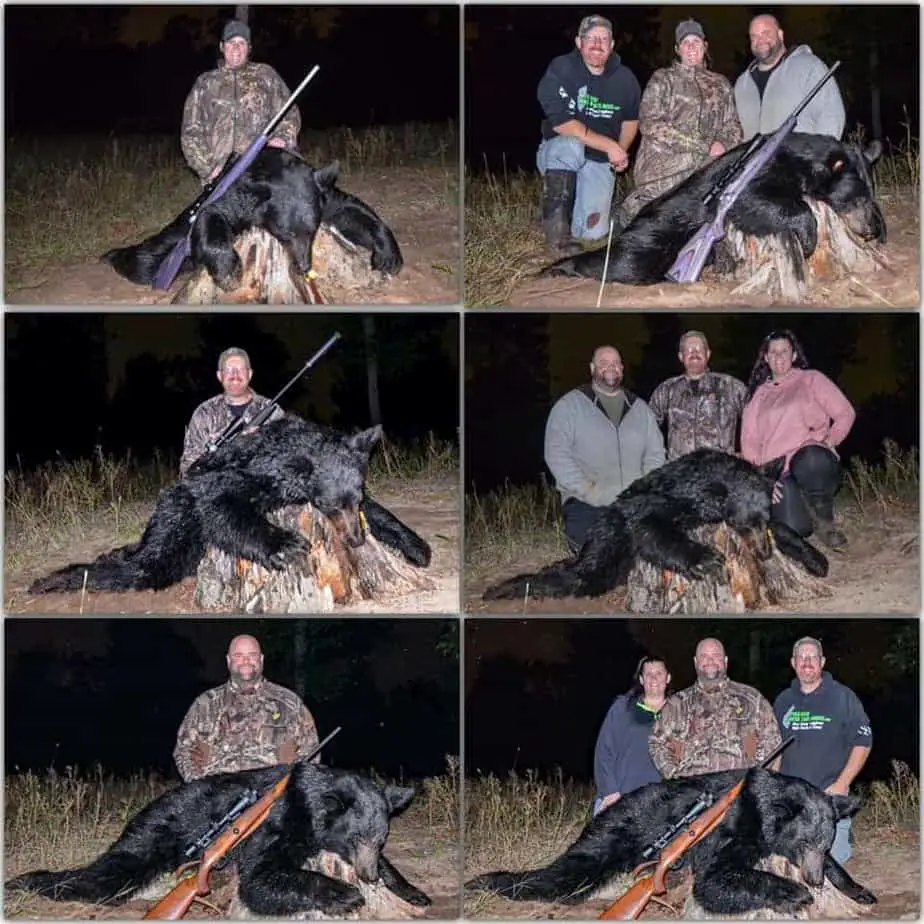
Pictured above: Chris Kreiner of www.greatoutdoorpursuits.com. Chris is an award winning predator caller.
Black bear habitat.
Black bears live throughout most of North America (except for the Great Plains). They prefer extensive deciduous or coniferous forests that offer thick ground foliage and rough terrain to use as cover. The best locations will host a variety of fruits and nuts and have a nearby water source.
Black bear diet.
About 85% of a black bear’s diet is vegetation. Hard-masts are a favorite. Look for oak acorns, hazelnuts, and whitebark pine nuts.
Fruits black bears eat include blueberries, dogwood, raspberries, strawberries, and blackberries.
Black bears also eat insects like grasshoppers, termites, ants, worms, wasps, and bees. Big honey fans will tear apart trees to reach the hives hidden inside.
If farms or orchards are nearby and the bears can get to them, they’ll also eat apples, corn, honey, and peaches.
Excluding carrion, black bears focus more on young whitetail fawns than adults. A ten-day-old fawn can outrun a black bear. Researchers believe bears can detect the scent changes a fawn undergoes at about day ten and will ignore them at that point.
Where baiting is allowed, it can draw in some monsters.
Related: How to tell a bear sow apart from a boar.
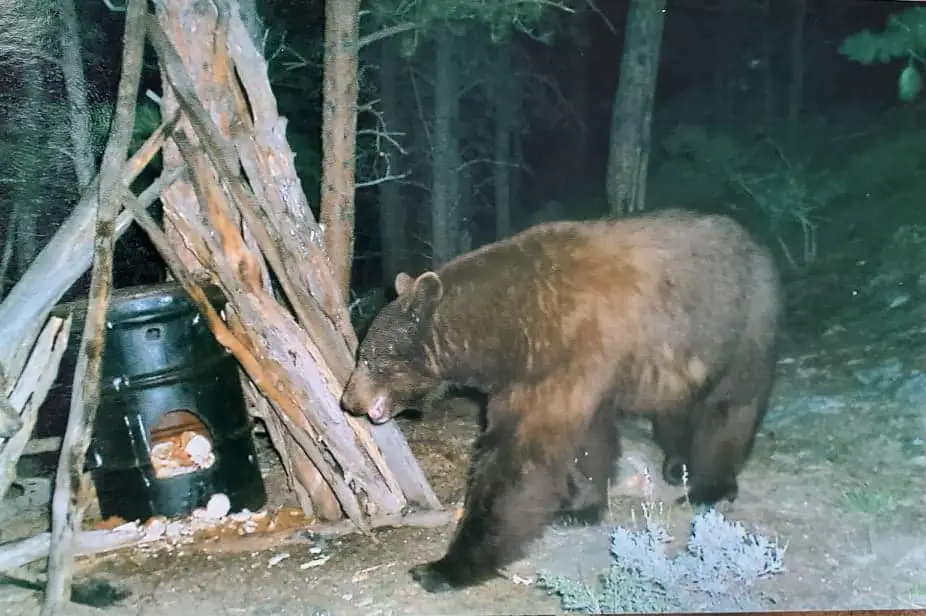
Hunting black bears using sign.
Black bear sign is the physical evidence left behind by the presence of black bears in the form of tracks, trails, paw prints, scat (feces), and tree rubs.
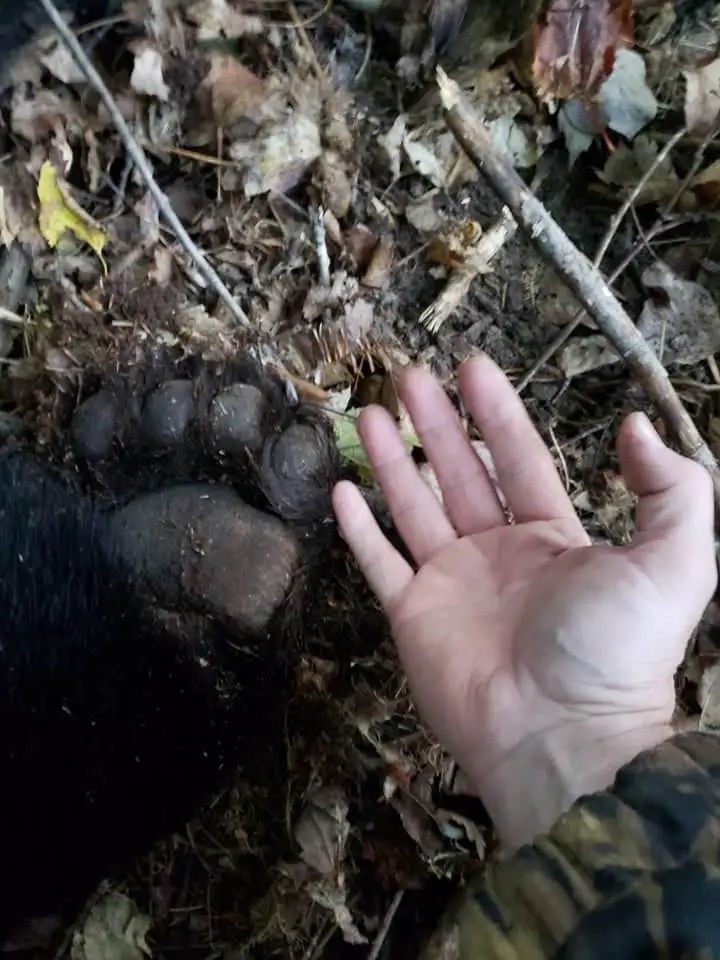
Black bear tracks.
Bears walk on the soles of their feet (plantigrade). So, unless they walk on soft dirt or in mud or snow (as seen below), there’s not likely to be a clear-cut track for you to discover.
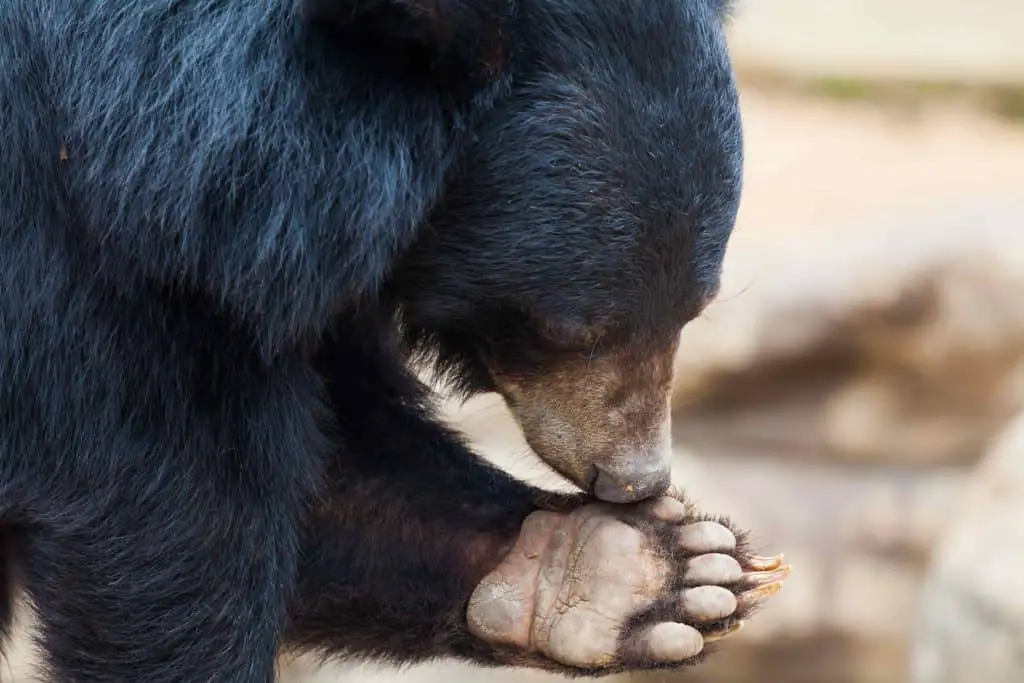
Recognizing a black bear’s print is simply a matter of noting the size of the print and the four or five toes on each paw. Yes, black bears have five toes, but, again, due to their walking style, the small inner toe on the outside of their feet doesn’t always make contact with the ground.
Related: Calling bears during the fall feeding frenzy.
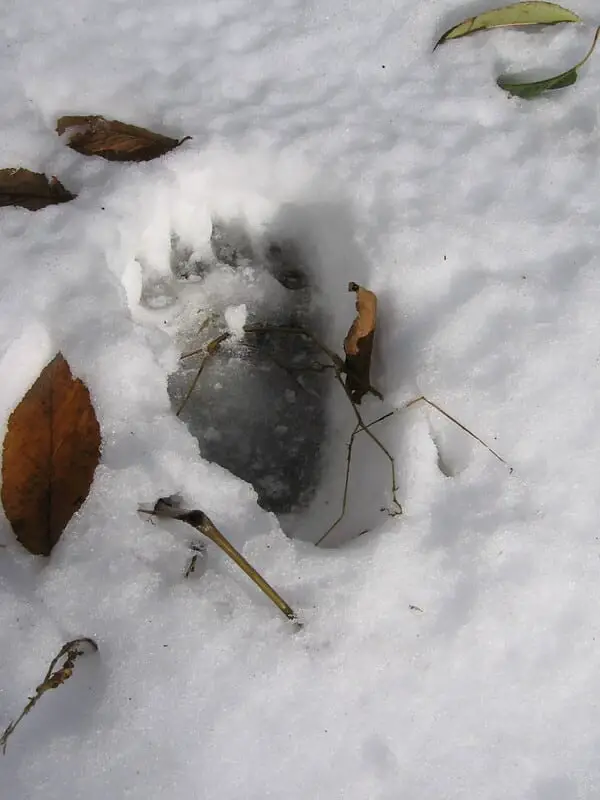
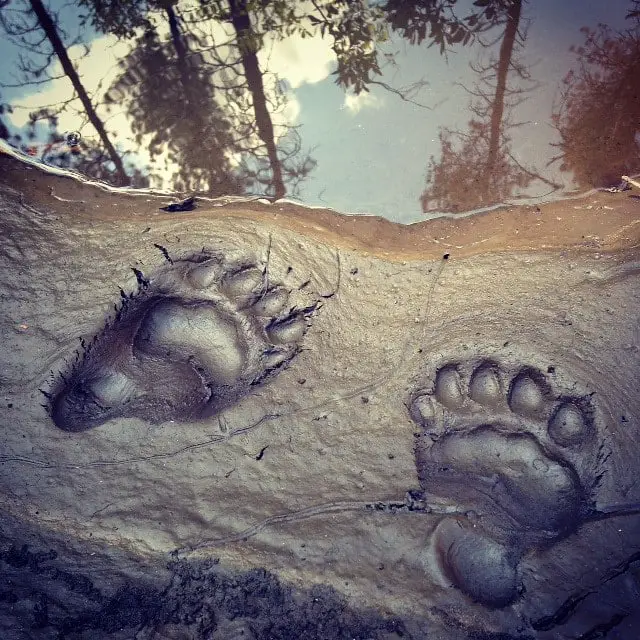
As with coyotes, foxes, and bobcats, a black bear’s front paws are wider than their rear paws.
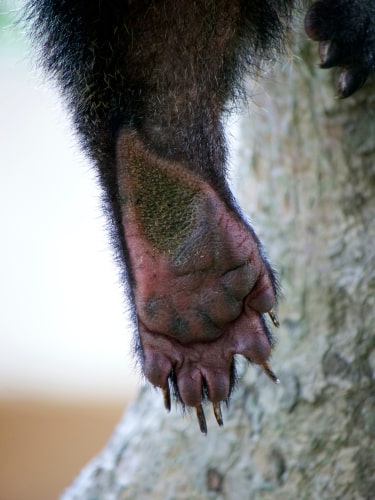
Aging tracks in sand, mud, and snow.
As noted, there are only three types of soil that capture good black bear prints; sand, mud, and snow. Here is how to age them in each medium.
When it comes to aging those black bear tracks you found, the weather in the days leading to your discovery is critical. While mud holds tracks the longest, snow is a frequent weather event during most regular black bear hunting seasons and often provides the best track aging information.
There are two degrees of freshness for black bear hunters when aging tracks: Tracks more than a day old and only 0-3 hours old.
Tracks older than one day provide you with proof that a black bear inhabits the land. For most hunters, this is enough to scout out the area for an excellent calling stand location and return later to hunt the spot.
0-3 hour old tracks mean anything from perhaps still within calling range to you spooked them coming into the area.
Aging black bear tracks in the snow.
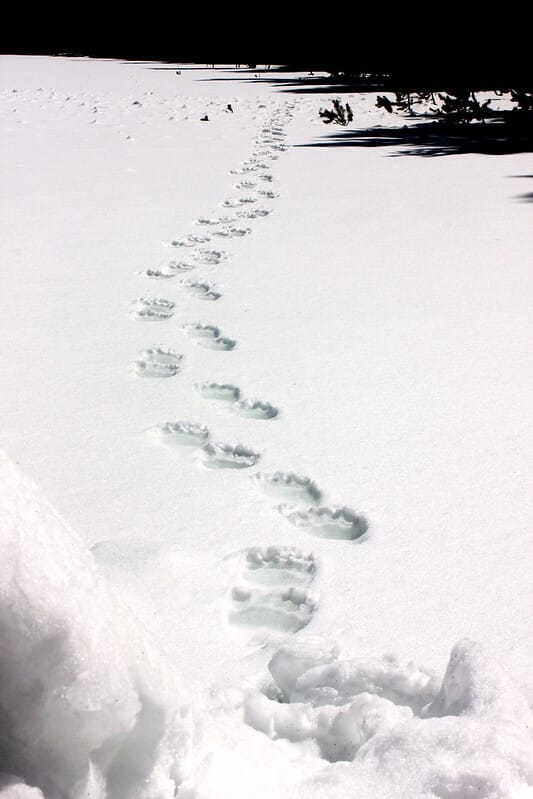
It’s all about the recent weather:
- Tracks in snow start sharp and clean.
- As the temperatures rise, those sharp edges round off.
- Ice crystals develop inside the print as temperatures dip below freezing.
Tracks in deep snow are harder to age than those in light snow. With deep snow, you’ll have to examine the kicked-out (excavated) snow to determine its age. Excavated snow is exposed to the elements, especially melting.
You know they were made after the last snowfall if good clear tracks in the snow have no snow in them.
Has any snow built up inside the track if the wind blows hard enough to move the snow on the ground?
If you find the track has an icy surface in the morning, then the print froze at some point overnight.
Check for ice crystals if you find clean, fresh tracks in the morning. No ice crystals mean it’s from that morning.
If you find a fresh sharp track when the temps are above freezing or the sun is shining, and the sky is clear, that track is new and hot. 0-3 hours.
Aging black bear tracks in the mud.
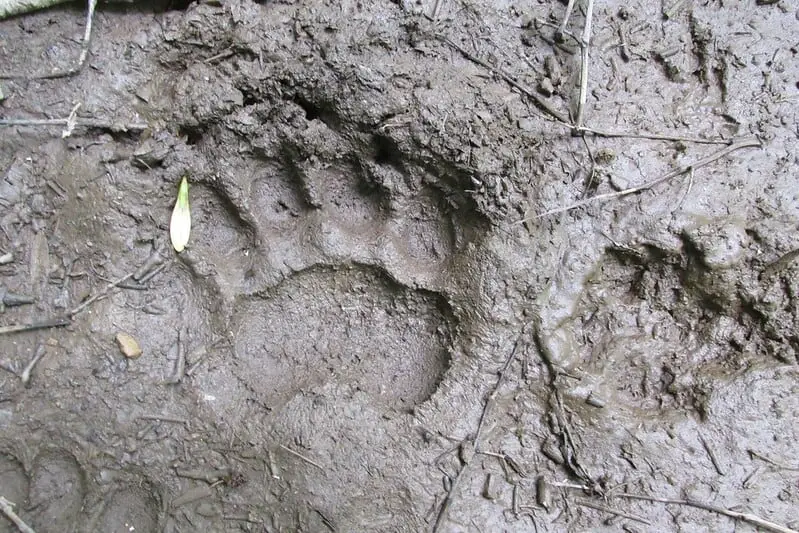
With mud, knowledge of recent weather still plays a critical role, but now we can add gravity to the list of things that aid you to track.
If a black bear fled minutes before you arrived and left tracks in the mud, here’s what you’ll find.
Along the outside of the print, there will be fissured walls and bits of soil. Gravity will soon pull these materials down into the track. If none have yet to fall, the print is exceptionally fresh.
As that track ages, the first changes occur in the color of the cracks and fragments displaced by the black bear’s paws. These slivers and the track’s edges will dry out faster than the print itself.
As time progresses, the track’s sharpness will dull, and its edges will round as gravity takes hold.
Eventually, debris will fall into the print, the rain will collect in it, and heavier rain will wash it away. Knowing what day it rained or when the wind would have been blowing strong enough to move debris into it will help you determine the track’s age.
Aging black bear prints in the sand.
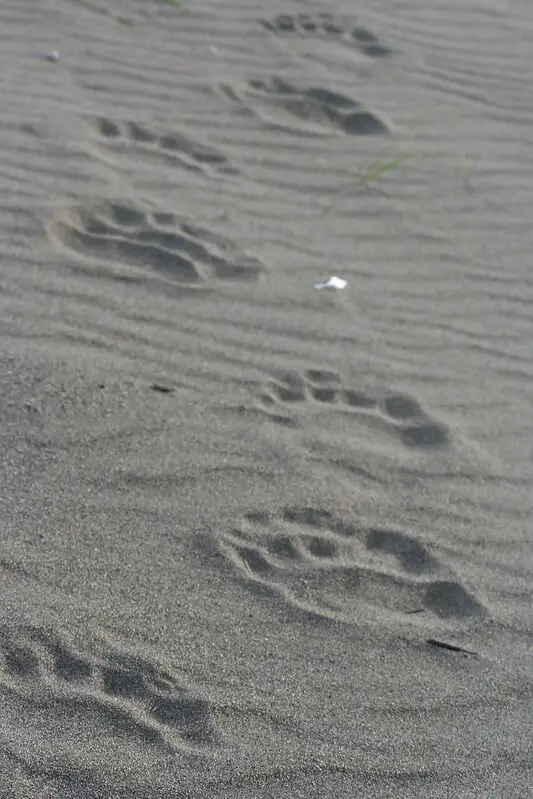
The freshest tracks in the sand will have raised surfaces near the crests of their walls that have not yet had time to begin to dry out. If you find a track in this condition on windy or sunny days, it’s 0-3 hours old.
A track found in the early morning with no dew is from after sunrise. If it has moisture in it, it’s from some point before dawn.
If the track appears fresh and dry but recently rained, it’s from after the rain ceased.
Black bear trails.
Seemingly like every other animal in the woods, black bears let the deer do all the heavy lifting (trailblazing) and stick to deer trails when not using logging roads or other artificial paths.
Heavily traveled bear trails, lanes created by multiple bears constantly traveling on the same ground for years, are easy to spot. The track will consist of a series of evident depressions in the land that mark where each bear stepped in the same spot as the preceding bear.
You will find bear trails at frequent road crossing sites and leading past marking trees.
How bears mark trails and how you can find them when hunting black bears.
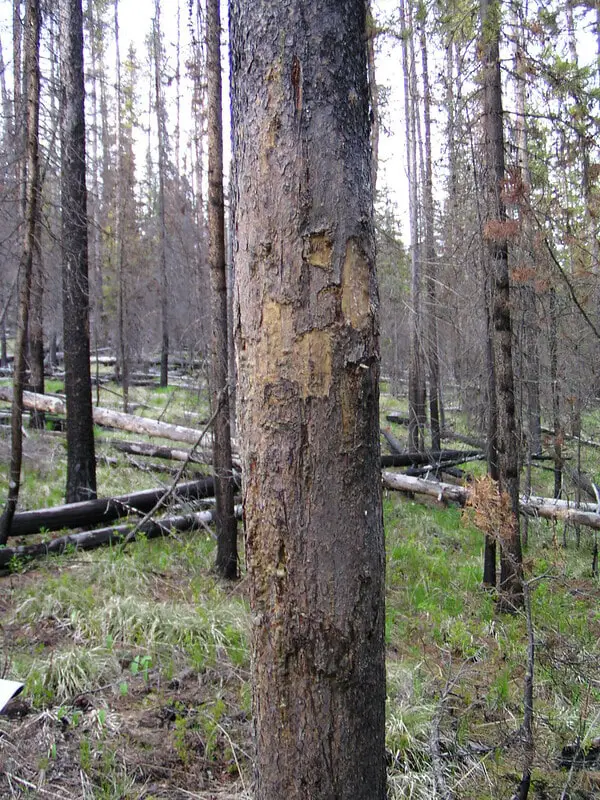
If you ever had a trail camera that got several pictures of a black bear approaching it was stripped off of the tree, you know black bears love rubbing against trees.
Rubbing and scratching their backs, heads, and shoulders is just one way black bears mark trees. Mark trees, that’s all they do with trees. Bears are not removing their winter coats, scratching an itch, or applying sap as insect repellent.
Bears mark trees, especially during mating season, to communicate with other bears. However, since most black bear territories mingle together at points, the males like to make their own “no trespassing” signs. They do this by putting their stink on a stick and scratching and biting trees that border their territory.
Okay, you get that rubbing leaves a scent behind, but what about the biting and scratching? Well, the first thing you notice about marked trees is their visibility. Marked trees are supposed to be seen by other bears.
Therefore, when another bear investigates a marked tree, it can use the rubbed in scent to identify the maker of the mark. However, the height of the scratches and bites tells them the size of the scratcher or biter.
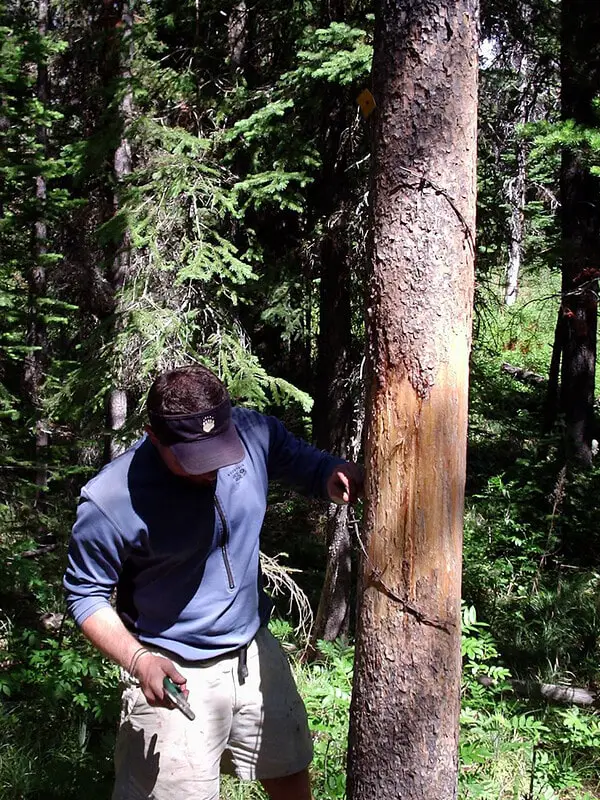
You’ll note that males make the marks, but both sexes investigate the marked trees? There is no proof boars mark trees. Boars have only been observed sniffing at them.
While all the reasons behind rubbing, scratching, and biting are interesting, it’s the sign left behind that helps you, the black bear hunter.
Bears mark trees frequently and often use the same tree for generations. These repeated marks leave a bear trail as prominent as blazed trees on a property line.
Find the marks, find the black bear’s property line.
What you should look for if the trail isn’t apparent to you. Leaning trees with little to no vegetation around them. Check for hair caught in the bark on these trees at about two to five feet high. Now check for scratch marks running vertically or note marks running horizontally between five and seven feet above the ground.
Once you have found a leaning-marked tree, you can find the trail by looking in the lean direction. The path near marked trees is easier to spot because the male bears will stomp and grind their feet as the walk up to the tree.
Stomping (another form of scent marking) further deposits the bear’s identity, sex, and reproductive status on the bear’s trail.
These trails are often incredibly distinctive because bears frequently stomp-walk as they approach such trees. Stomp-walking is scent-marking in which bears stomp, twist, and slide each footstep.
Identifying black bear scat.
Black bear scat is 1.5 to 2.5 inches in diameter and up to a foot long. The scat can weigh up to a pound (though putting black bear scat on a scale takes your scouting a bit too far).
If there’s enough hair and grasses in it, it will be tubular, with one end slightly tapered and the other rounded or flattened. If the bear has consumed a lot of fruits and berries, it will look like a fat pancake.
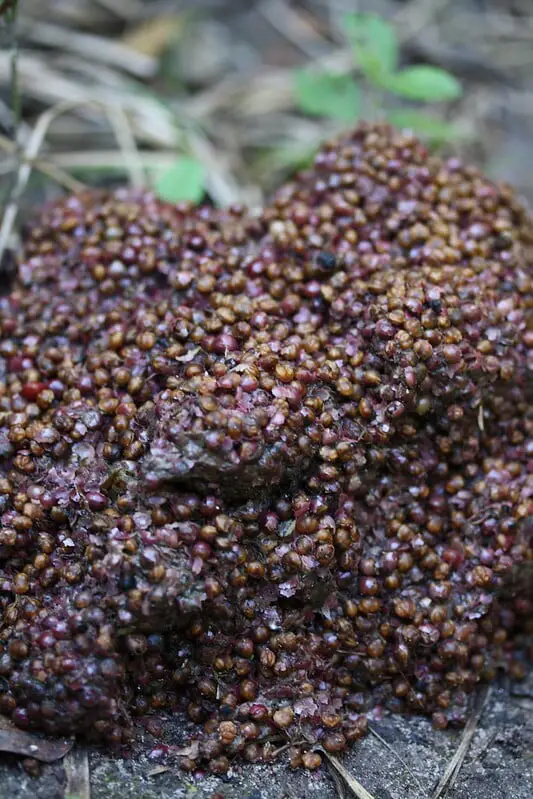
Black bear scat consists of bug parts and vegetative matter in the spring, fruit and berry seeds in the fall, and bones and hair from carrion in the winter.
Black bear scat is brown or black, most of the time, but almost green if the bear has been consuming a lot of grasses.
The smell of black bear scat is not unpleasant like a coyote or foxes. However, since 85% of a black bear’s diet consists of fruits, nuts, or vegetation, it usually smells like whatever it has been eating the most.
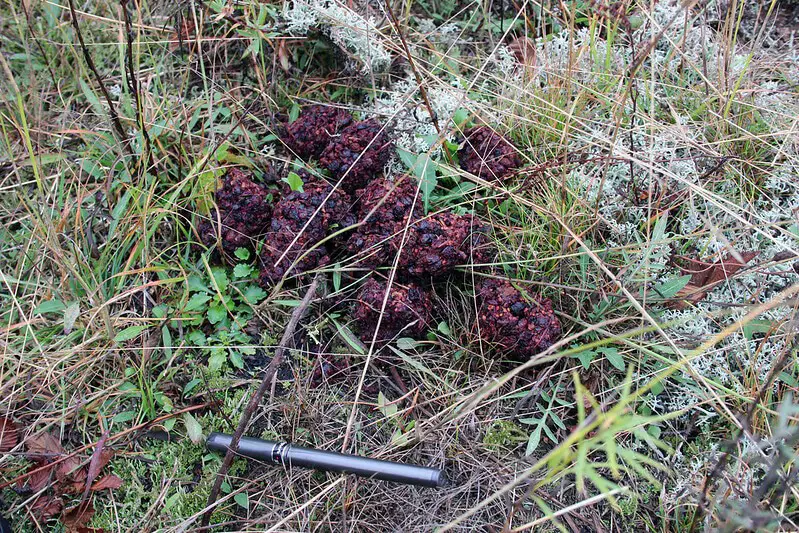
Look for black bear scat on bear trails, deer paths, or logging roads. You will also find it at the base of some trees.
Black bear gender identification.
Bruin, boar, or sow?
Determining the sex of a black bear as a new hunter can be difficult. However, most of us start out knowing that the females (boars) travel in groups (with their cubs).
But such limited knowledge could lead to some legal trouble. For instance, in New York, bear hunting occurs in two zones (North and South). It is much easier to tell the difference between a cub and an adult black bear in the Northern Zone.
In the Southern Zone, where food is in much greater abundance, a male cub may already be larger than a year old female by bear season. The trouble, it’s illegal to take a cub in the Southern Zone.
The potential penalty for taking a cub? It’s a misdemeanor.
“The illegal taking of a bear less than one-year-old or the taking of a bear by a means or method not permitted by this chapter. Such misdemeanor shall be punishable by imprisonment for not more than one year or by a fine of not more than two thousand dollars, or by both such imprisonment and fine.” https://www.animallaw.info/statute/ny-enforcement-conservation-article-71-enforcement
New York black bear hunters get a little help from the state.
The information provided by New York to help you prevent taking a cub (remember, in the Southern Zone, they can be a large as momma)?
1. Cubs and younger bears have big ears relative to the size of their heads. If the ears look big, then the bear is small. Also, the ears are closer together on young and small bears
2. Mature bears, especially males, have a large blocky head. The head tends to resemble a basketball on top of the shoulders. If the head is smaller with slight or pointed features, it is likely a younger bear.
3. A mature bear has a belly that droops down and causes it to walk with a swagger.
4. If you see a bear, it is best to observe it for a while before deciding to take a shot. If the bear is a sow with cubs, you will see and/or hear them before too long.
5. Bear hierarchy is based on size. Smaller bears will often approach warily, periodically looking around for larger bears. Alternatively, larger bears tend to travel with a purpose and may appear oblivious to their surroundings. https://www.dec.ny.gov/docs/wildlife_pdf/bbhunting10.pdf
Black bear male vs. female?
As helpful as the above information is, a new black bear hunter could still have trouble telling the difference.
However, there are three (nearly) certain ways to tell a male black bear apart from a female.
- Males tend to squat and urinate forward and inward of their bodies.
- Females usually don’t squat and urinate rearward and away from their bodies.
- If there are cubs in attendance, it’s a sow.
Need more information, might I suggest you watch this video:
Taking a trophy when hunting black bears.
Look, the first bruin you take will be a trophy to you. However, as you get more experienced, you’ll want to hunt much larger black bears.
For black bears, trophy size classification starts with age. Mature males five years and older are much larger and heavier than younger bears. As far as weight goes, a bear weighing for than 300 pounds is a definite winner, but they can weigh more than twice that amount.
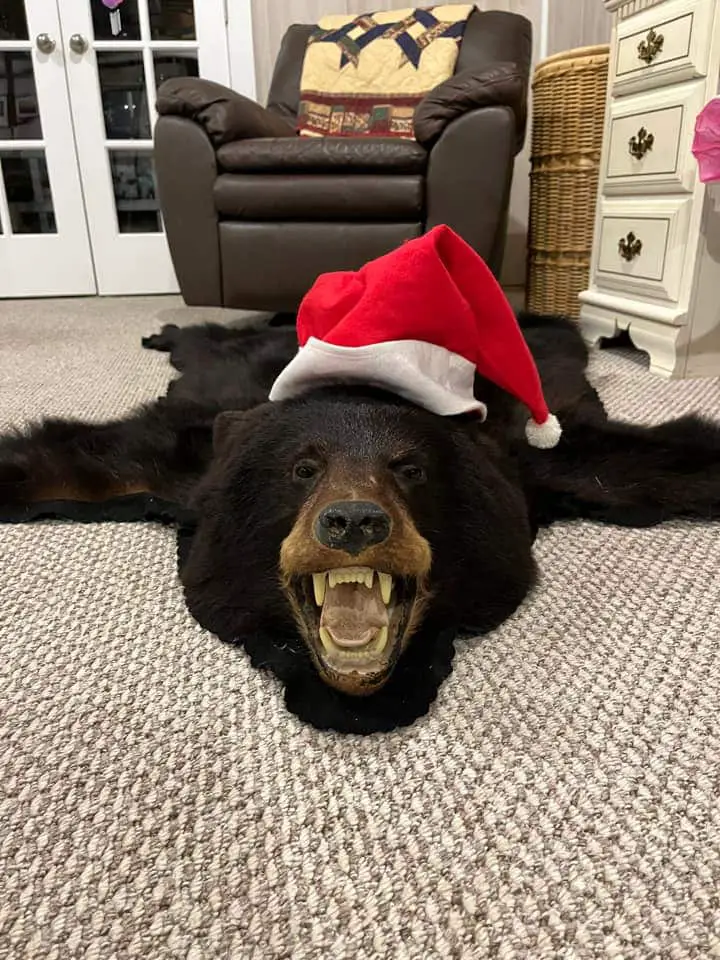
A mature male bear will waddle as it walks, swaying its massive front shoulders and nearly touching the ground with its droopy belly. Its ears will seem too small for its head and look pushed too far apart.
Truly giant black bears have pumpkin-sized heads and skulls so large it looks like they have a valley cut into the center of their foreheads.
Because a black bear’s skull never stops growing, it continues to get larger as the bear ages. This ever-increasing size, and the accumulation of battle scars on its face, can help you determine a bear is worth the tag.
Need more help? Well, I got just the video for you!
Shot placement when hunting black bears.
There are two tips to making a clean, quick kill on a black bear; hit the vitals and create an exit and entry wound.
Your first rule is to stay calm and wait for your shot. Shooting a moving bear is a low-probability gamble. At best, you could spend the rest of your weekend tracking a mortally wounded bear and never find it.
Wait for the bear to stop and present a broadside target. With the adrenaline streaking through your veins, you’ll have the jitters. Therefore, your best hope of hitting the vitals is to wait for the bear to stop, present a broadside target, and aim for a double lung shot.
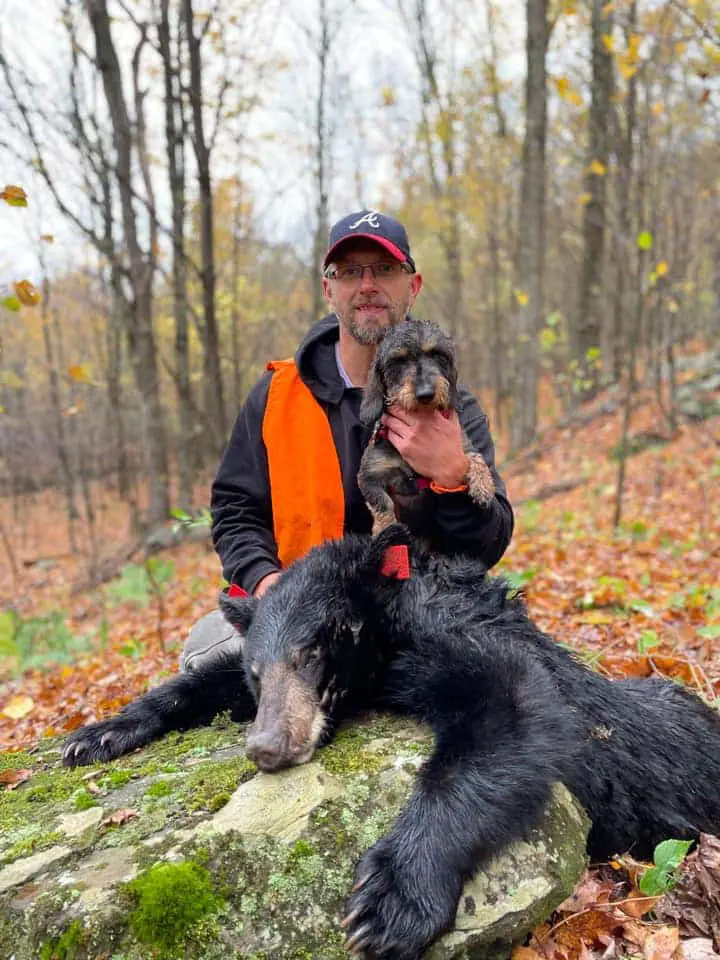
David Madore told us he and Winston tracked this bear for two days, before catching up to and dispatching him in the Catskill Mountains. The tags in the ears are from being released after rehab (Car vs. Bear). The black bear was harvested over 30miles away in straight line from where it was released.
D&W Big Game Tracking is located in Albany, NY and serves the surrounding areas. Dave and Winston can be reached at their facebook page: D&W Big Game Tracking
Create an entry and exit wound when shooting black bears.
Black bears are nearly impossible to blood trail. Their hair soaks up the blood, and their fat clogs most wounds. And remember their habitat and where you are hunting them? Do you want to track a giant wounded bear in thick brush and densely wooded terrain?
With a bear stopped and broadside to you, a well-aimed shot has a much great chance of passing entirely through its body. If the shot is aimed at the lungs, both lungs will be destroyed, and the bear will quickly expire and leave an easily followed blood trail.
I also write about hunting red and gray foxes at night.
The best place to shoot a black bear.
Where to aim?
The old saying is, “aim for the middle of the middle.” A center mass shot like this, however, presents a few problems. If you hit too far forward, you could hit a shoulder. If too far back, you can miss the lungs. Too low, an easy mistake to make on a large bear, results in a lot of blood at first, but the bleeding quickly stops, and you are in for a long and possibly fruitless search.
The modified “aim for the middle of the middle and then a few inches forward toward the shoulders” is the perfect aiming point.
If you have never seen a bear, this video demonstrates the perfect shot placement on real live bears.
If your shot is perfectly placed, the bear won’t get very far. What may happen next, however, can be a little unsettling if you don’t expect it.
Some dying black bears utter a startling and spooky sounding death moan. Like this one:
Calling in black bears.
The short version? When you see a black bear, grab your favorite rabbit in distress call and hammer it for all your worth until the dang blame bear is close enough to arrow or shoot.
Short version with free advice (I get nothing for recommending this darn company, but Brian makes great callers)? When you see a bear, grab your Rush Custom Caller Rabbit Squealer and hammer it for all…
It’s funny because it’s true. Your best odds of calling in a black bear are after you see one (spot and stalk). And, they lose interest fast, so you have to keep calling right up until they offer you a close-range, broadside target.
Just about any distress call will work. Just remember to make it sound mournful and pitiful.
If you’re are simply calling blind from a stand you chose based on solid scouting, plan on calling for at least 45 minutes. Continuously. Without a break. Call until your hunting buddy sees a red glow emanating from your lungs without the use of a thermal viewer.
Think coyotes are rude? Try calling in a well-fed 400-pound bear by offering him 8 ounces of rabbit meat. That bear is going to take his sweet time, and your lungs are going to burn like those of a Marine drill instructor screaming at a platoon of deaf recruits. The second you stop, Mr. Black Bear will forget all about you and turn away.
The only good news? You aren’t predator hunting at night! You can see your target, gauge its reaction, and adjust the tone, pitch, and “oh, please keep coming closer” frequency.
Interested in hunting eastern coyotes at night? Try my book!
Calling black bear in heavy timber.
Much like the spot and stalk method, your primary job on a stand in heavy timber is to keep calling until you see a bear. That’s it; that’s all there is to it.
However, in heavy timber, you may have no idea if a bear is nearby. Black bears tiptoe in the woods. The terrain and vegetation may block your sight of it. If you start calling at too loud a volume, you may scare off a nearby bear.
The upside is, a bear within a few hundred yards of you in heavy timber is likely to come to your call.
Calling black bears with cub in distress
The last call I’ll recommend is the bear cub in distress. The bawling sound of a hurt cub can trigger either a protective response (sow) or a territorial one (boar).
Regardless of which sex responds, the response will be aggressive. The bear that comes to a cub in distress is looking for trouble, and you need to be ready for action.
Cub distress sounds are great, but everyone involved expects, or should expect, a fight.
Dragging a black bear out of the woods.
There’s a saying about how hard it is to get people to hunt bears. It goes like this, “The hardest person to get to go bear hunting is someone who has done it successfully before.”
Dragging a bear is like pulling hundreds of pounds of jelly inside a heavy-duty garbage bag. It’s exhausting.
The bear’s limbs get caught under roots and wrapped around trees. The bear stinks and draws every insect for miles around. The damn thing looks human. It feels heavier and harder to move, even downhill.
Your heart rate will explore new limits. Your lungs, already ruined from all that calling, are ready to burst. And to top it all off, you fall once for every two steps you take.
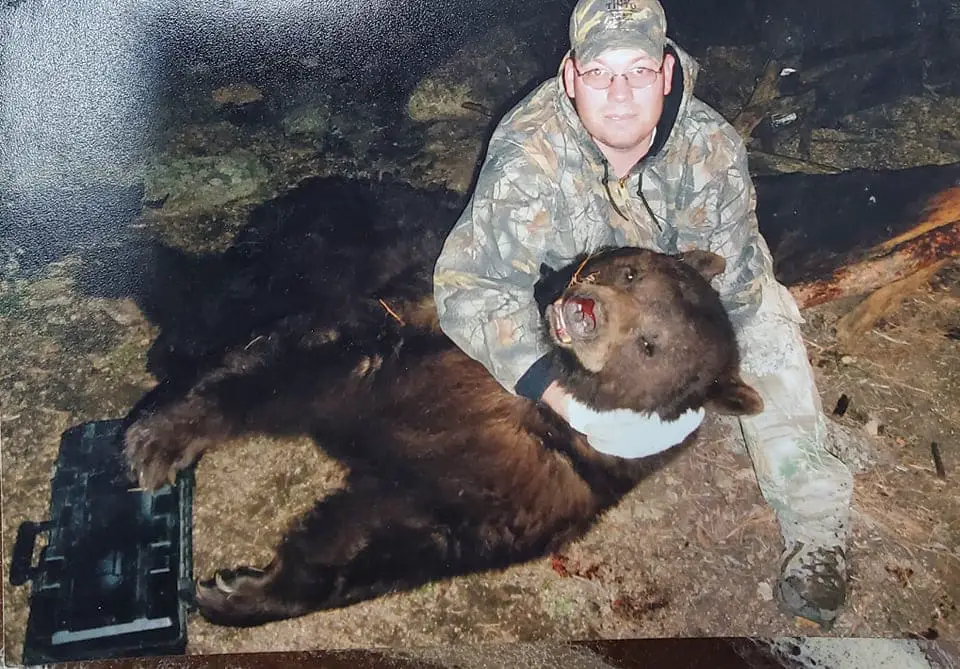
Make your life easier when you drag a black bear.
At the very least, if you have taken a bear you would share a picture of, you’ll need a good friend to help you. Someone you trust. Someone who always has your back. Alternatively, it can be someone who wouldn’t care to get a visit from a game warden if he got a hot tip about stalkless corn growing in 50 pounds piles.
If you have shot a 300-pound black bear, you better have two people on speed dial. These two folks better have active search warrants out on them, or you won’t be able to convince them to help you.
If you have taken a 500-pound trophy, take lots of photos. Unfortunately, both of you will soon be dead.
Seriously, the weight is just part of the problem. The real source of disgust is there isn’t a single place to get a grip on and take hold of a black bear.
I’m lucky here. I am a construction safety professional. I have access to fall protection harnesses and shock-absorbing lanyards. Properly donned, I become a human mule and lean in and walk forward.
Don’t put the cart before the pickup truck when hunting black bears.
A heavy-duty game cart with a tow hitch won’t solve all your problems, but in those clear spots in the woods, it’s a lifesaver. The tow hitch lets you attach it to a fall protection harness and lanyard.
A heavy-duty cargo rack carrier for your pickup truck will let you transfer your black bear from the cart or ground to less than half the height of your truck’s bed. Without it, you may well leave the damn bear on the side f the road in a combination of complete frustration and exhaustion.
After a successful day hunting black bears.
Once you are home with your black bear, there’s still a metric ton of work to do. Skinning, caping, and butchering must all be done before you get even your first taste of bear bacon.
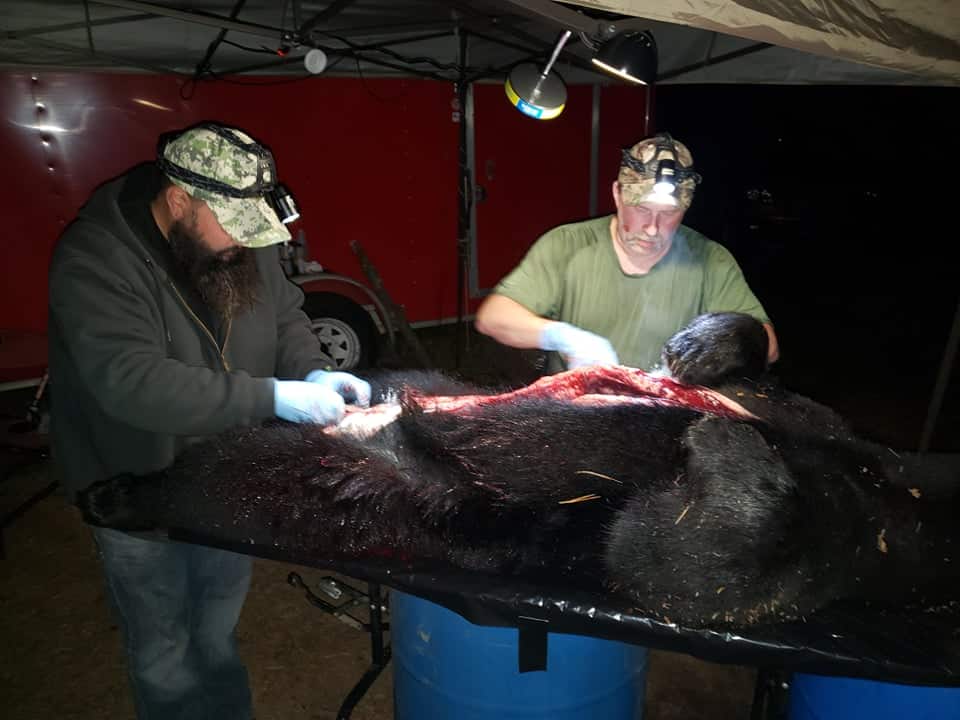
But’s that a whole different story. So, for now, go ahead, and dream of hunting black bears young predator hunter. And pray you only read about the 800 pounders that could be stalking your neck of the woods.

